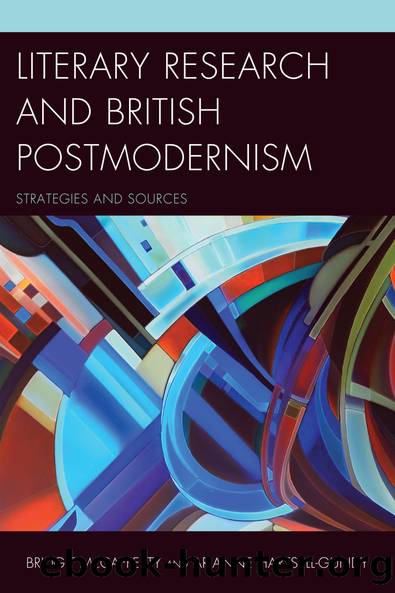Literary Research and British Postmodernism by unknow

Author:unknow
Language: eng
Format: epub
Publisher: Rowman & Littlefield Publishers
Published: 2015-08-15T00:00:00+00:00
Chapter Eight
Manuscripts, Archives, and Digital Collections
Though many primary sources and archival materials are now available through microform and digital collections, there are still many items that are only available through physical archives and special collections. We are still some time away from a world where all research can be completed online, due to the limitations in the time and money required to digitize everything, as well as the barriers of copyright. Even if a digital reproduction or a facsimile version exists, you should still visit the physical object in order to identify features like watermarks to verify that the reproduction is faithful to the original or to better read someoneâs handwriting. As a result, original research often requires a visit to an archive.
This chapter discusses how to identify archival collections, along with tips about doing archival research, finding documents, and scheduling time at facilities with these resources. The information provided here will help you be more prepared to visit such an institution, which will make the time spent completing the research more fruitful. Keep in mind that postmodern authors are in many cases still alive, so they might not have donated any of their personal papers or original manuscripts to an institution yet, which probably represents the biggest barrier to archival research of postmodern authors. Still, discounting archival research for any literary period would be a mistake. In many cases, the primary documents held in archives are at the heart of our discipline and should receive pride of place in any serious research project.
Defining Archives and Manuscripts
Archives are often housed in libraries, especially in university libraries, but they can also be found in government buildings, businesses, newspapers, historical societies, and museums. Though libraries and archives share many features, they are actually different institutions with unique purposes and a variety of resources. You might find distinctive search methods, and the tools to use them are necessary. Libraries tend to collect secondary sources, and they purchase them through publishers or vendors one item at a time, either through an approval plan (agreement with a vendor to provide for the automatic delivery of new materials) or through a selection process that considers reviews and recommendations. In contrast, archives almost exclusively collect primary sources and often purchase them as one complete collection. A common example of this is when an authorâs relative donates all of the personâs papers after his or her death. Archivists might take many years to organize, describe, and catalogue this collection if it is quite large. As a result, you might have to sort through a lot of documents to find relevant information. This process can be time-consuming and frustrating, though it might also produce serendipitous results.
Libraries usually collect published works, like books and periodicals. Archives are more likely to hold unpublished, unique works such as organizational records, personal papers, notebooks, journals, letters, and oral histories. Formats such as photographs, slides, films, computers, or audio recordings might also be included in archives. Many of these items are one of a kind and worth a considerable amount of money.
Download
This site does not store any files on its server. We only index and link to content provided by other sites. Please contact the content providers to delete copyright contents if any and email us, we'll remove relevant links or contents immediately.
The Power of Myth by Joseph Campbell & Bill Moyers(697)
Four Shakespearean Period Pieces by Margreta de Grazia(694)
A Social History of the Media by Peter Burke & Peter Burke(645)
Inseparable by Emma Donoghue(616)
The Complete Correspondence 1928-1940 by Theodor W. Adorno & Walter Benjamin(515)
Bodies from the Library 3 by Tony Medawar(489)
The Spike by Mark Humphries;(477)
A Theory of Narrative Drawing by Simon Grennan(471)
Culture by Terry Eagleton(470)
World Philology by(458)
Ideology by Eagleton Terry;(456)
Farnsworth's Classical English Rhetoric by Ward Farnsworth(448)
A Reader’s Companion to J. D. Salinger’s The Catcher in the Rye by Peter Beidler(434)
Adam Smith by Jonathan Conlin(427)
Comic Genius: Portraits of Funny People by(415)
Game of Thrones and Philosophy by William Irwin(405)
Monkey King by Wu Cheng'en(405)
High Albania by M. Edith Durham(401)
Early Departures by Justin A. Reynolds(386)
